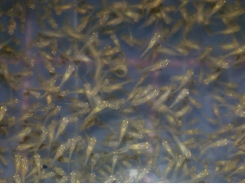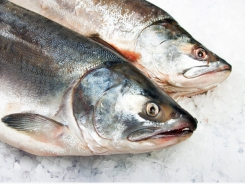Largemouth bass responses to supplemental EPA, DHA

Ten-week study shows dietary supplementation of essential fatty acids may be required
The largemouth bass is one of several commercially important farmed fish species for which conclusive evidence on the beneficial effects of dietary supplemental EPA- and DHA-rich ingredients remains very limited.
In recent years, the aquaculture industry has faced a rapid shift in raw materials used in feed formulations with a departure from marine-based to (largely) terrestrial plant-based nutrient sources. Accurate information on ingredient nutrient (and anti-nutrient) composition and availability and the nutritional requirements of relevant species is a priority for the development of sustainable aquaculture.

View of the experimental setup where the study was conducted.
It is broadly accepted that freshwater fish species are able to synthesize the omega-3, long-chain, highly unsaturated fatty acids eicosapentaenoic acid (EPA) and docosahexaenoic acid (DHA) from linolenic acid (LNA) to meet their physiological needs. However, positive responses to dietary supplementation of EPA- and DHA-rich oils have been reported in typical freshwater fry or juvenile fish, including channel catfish (Ictalurus punctatus) and hybrid tilapia (Oreochromis niloticus × O. aureus). The general paucity of scientific literature on fatty acid requirements and their roles in metabolism and immunity for a range of cultured fish species is a constraint for developing cost-effective feed formulations that optimize health and promote growth.
The largemouth bass (LMB), Micropterus salmoides, is one of several fish species of commercial importance in aquaculture for which conclusive evidence on the beneficial effects of dietary supplemental EPA- and DHA-rich ingredients remains very limited. Therefore, in view of the increased interest and expansion of LMB production for food fish markets in North America, our objective in this study was to assess the effects of supplemental EPA- and DHA-rich oils on the production performance, muscle fatty acid composition and the expression of genes related to metabolism and immunity of LMB. This research was supported by the U.S. Department of Agriculture Evans-Allen Research Program (Accession No. 1008396). The authors would like to thank all students of the Fish Nutrition Laboratory, Kentucky State University Division of Aquaculture for their assistance during this study.
Study setup
Twelve experimental diets were formulated to contain 45 percent crude protein (CP), 12 percent lipid, and different levels (0 percent, 1 percent and 2 percent) and ratios (20:80, 30:70, 40:60, 50:50, 60:40, 70:30, and 80:20) of EPA and DHA (Table 1). A diet depleted of omega-3 fatty acids (1; containing 0.27 percent n-3 fatty acids and 0.05 percent EPA+DHA) and a LNA-rich (4.35 percent) diet (2) were formulated using coconut and linseed oils, respectively.
Seven additional diets were formulated to contain 1 percent EPA+DHA at the aforementioned ratios using purified fish oils. A final set of three diets were formulated to contain 2 percent EPA+DHA at 20:80, 50:50, and 80:20 ratios. After diets were mixed, the experimental diets were screw-pressed through a 3-millimeter die plate using an industrial meat grinder, dried at room temperature under forced air, broken into pellets, sieved, and stored at minus-20 degrees-C until used.
Rossi, LMB trials, Table 1
| DIET | 1 | 2 | 3 | 4 | 5 | 6 | 7 | 8 | 9 | 10 | 11 | 12 |
| EPA+DHA (%) | 0.04 | 0.04 | 1.0 | 1.0 | 1.0 | 1.0 | 1.0 | 1.0 | 1.0 | 2.0 | 2.0 | 2.0 |
| EPA:DHA (%) | - | - | 20:80 | 30:70 | 40:60 | 50:50 | 60:40 | 70:30 | 80:20 | 20:80 | 50:50 | 80:20 |
| Protein | 45.2 | 45.6 | 45.2 | 46.4 | 46.1 | 45.7 | 45.6 | 45.7 | 45.7 | 45.6 | 46.0 | 44.9 |
| Lipid | 12.3 | 13.0 | 12.8 | 13.0 | 12.8 | 12.7 | 12.8 | 12.6 | 12.5 | 12.7 | 12.6 | 12.6 |
| Crude fiber | 1.8 | 3.4 | 2.0 | 2.1 | 2.2 | 2.4 | 2.0 | 3.5 | 2.4 | 2.5 | 2.8 | 2.5 |
| Ash | 13.3 | 13.7 | 13.7 | 13.6 | 13.5 | 13.3 | 13.6 | 13.7 | 14.0 | 13.7 | 13.8 | 13.5 |
| Fatty acids Sat | 3.95 | 2.46 | 2.40 | 2.37 | 2.35 | 2.30 | 2.30 | 2.26 | 2.24 | 2.29 | 2.05 | 2.15 |
| n-9 | 0.15 | 0.17 | 0.21 | 0.21 | 0.20 | 0.19 | 0.19 | 0.18 | 0.17 | 0.26 | 0.22 | 0.18 |
| n-6 | 2.46 | 3.52 | 3.55 | 3.58 | 3.59 | 3.52 | 3.56 | 3.55 | 3.52 | 3.58 | 4.02 | 3.71 |
| n-3 | 0.27 | 4.40 | 4.18 | 4.32 | 4.27 | 4.19 | 4.24 | 4.16 | 4.11 | 4.04 | 3.36 | 4.11 |
| n-6:n-3 | 9.02 | 0.80 | 0.85 | 0.83 | 0.84 | 0.84 | 0.84 | 0.84 | 0.86 | 0.89 | 1.20 | 0.90 |
| LNA | 0.21 | 4.35 | 3.27 | 3.34 | 3.30 | 3.24 | 3.26 | 3.20 | 3.14 | 2.18 | 1.79 | 2.20 |
| EPA | 0.02 | 0.02 | 0.21 | 0.31 | 0.40 | 0.49 | 0.59 | 0.66 | 0.75 | 0.43 | 0.79 | 1.50 |
| DHA | 0.03 | 0.02 | 0.67 | 0.63 | 0.54 | 0.44 | 0.36 | 0.27 | 0.20 | 1.36 | 0.73 | 0.38 |
| EPA+DHA | 0.05 | 0.04 | 0.88 | 0.94 | 0.94 | 0.92 | 0.95 | 0.94 | 0.95 | 1.80 | 1.52 | 1.87 |
| Final EPA:DHA ratio (%) | - | - | 23:77 | 33:67 | 43:57 | 53:47 | 62:38 | 71:29 | 79:21 | 24:76 | 52:48 | 80:20 |
Design and analyzed composition of the experimental diets fed to juvenile largemouth bass (13.8 g initial weight) for 10 weeks.
LNA = linolenic acid; EPA = eicosapentaenoic acid; DHA = docosahexaenoic acid.
Feed-trained juvenile LMB (~5 g) were obtained (Cain Fish Farm, McCrory, Ark.) and transported to the Aquaculture Nutrition Laboratory located at the Aquaculture Research Center (Kentucky State University, Frankfort, Ky.). Following acclimation, fish were stocked into a 2,000-liter fiberglass tank operating as a recirculating aquaculture system (RAS) and fed with a commercial feed (45 percent CP, 15 percent lipid) until attaining adequate size for the feeding trial. Upon commencement of the feeding trial, groups of 15 LMB (average initial weight: 13.8 g) were sorted by hand and stocked into 36 110-liter glass aquaria operating as a RAS.

View of the juvenile LMB in the study being fed.
After a one-week conditioning period, experimental diets were randomly assigned to aquaria (in triplicate) and fish were fed twice daily to apparent satiation. Water quality parameters were maintained within acceptable ranges for LMB and a 12-hour photoperiod was employed using fluorescent lighting controlled by timers. At the end of the feeding trial, fish from each aquarium were group-weighed, counted, and a representative number of fish sampled for data collection. All resulting data was analyzed by orthogonal contrasts using statistical analysis system (SAS) software.
Results and discussion
The LMB juveniles readily accepted and fed actively on all experimental diets. We found no significant effects of EPA:DHA ratio on all response parameters evaluated (P<0.05). Results from a two-way analysis of variance on a subset of dietary treatments (3, 6, 9, and 10-12) representing a complete 2 × 3 factorial design reveled no effects of EPA and DHA level and ratio or their interaction (P<0.05; data not shown).
Likewise, we found no significant dietary effects after performing orthogonal contrast analyses of LMB final weight and feeding rates among selected treatments (Table 2). Despite excellent survival in all treatments, fish fed diet 2 containing high omega-3 and negligible EPA+DHA (0.05 percent) displayed lower survival than those fed diets 3-9 containing 0.9 percent EPA+DHA (P = 0.033).
Rossi, LMB trials, Table 2
| Diet | EPA+DHA (%) | Final weight (g) | Feeding rate (%BW/day) | Survival (%) |
| 1 | 0.05 | 107 ± 2.4 | 3.8 ± 0.09 | 97.8 ± 1.8 |
| 2 | 0.04 | 113 ± 4.1 | 3.9 ± 0.15 | 95.6 ± 3.6 |
| 3 to 9 | 0.93 ± 0.01 | 117 ± 0.9 | 3.7 ± 0.02 | 99.7 ± 0.2 |
| 10 to 12 | 1.73 ± 0.05 | 116 ± 1.0 | 3.8 ± 0.02 | 99.3 ± 0.4 |
| CONTRASTS (Pr > t) | ||||
| 2 – 1 | n/a | 0.391 | 0.470 | 0.369 |
| 2 – (3 to 9) | n/a | 0.417 | 0.187 | 0.033 |
| (3 to 9) – (10 to 12) | n/a | 0.788 | 0.355 | 0.720 |
Production performance of juvenile largemouth bass (13.8 g initial weight) after ten weeks of feeding the experimental diets. Means ± SE.
n/a = not applicable. SE = standard error.
Interestingly, contrast analyses on weight gain (Fig. 1) and feed efficiency (Fig. 2) showed that LMB fed diets 3-9 outperformed those fed diet 2 (P<0.05), corroborating previous data that LMB have limited ability to synthesize EPA and DHA from LNA (Subhadra et al 2006). In addition, the lack of significant differences between dietary treatments 1 and 2 for all performance parameters evaluated (Table 2; Figs. 1 and 2) suggest that LMB has a low dietary LNA requirement.

Fig. 1: Weight gain of juvenile largemouth bass (13.8 g initial weight) after feeding the experimental diets for ten weeks. Connecting lines specify orthogonal contrasts between diets and/or diet groups. Error bars represent SE.

Fig. 2: Feed efficiency of juvenile largemouth bass (13.8 g initial weight) after feeding the experimental diets for ten weeks. Connecting lines specify orthogonal contrasts between diets and/or diet groups. Error bars represent SE.
Perspectives
Further investigations are recommended to determine whether the study’s observed responses were linked to age and growth rates of the fish, nutrient density (and performance) of the diets, or the combination thereof.
Although preliminary relative to all pending complementary results, our current findings indicate largemouth bass has a dietary requirement for EPA and/or DHA for maximal growth and nutrient utilization. The potential requirement will be investigated further in a dose-response feeding trial.
Further investigations to determine whether the observed responses were linked to age and growth rates of the fish, nutrient density (and performance) of the diets, or the combination thereof also are indicated.
References available from corresponding author.
About Authors:
WALDEMAR ROSSI JR., PH.D.
- Research Associate – Aquaculture Nutrition
- Division of Aquaculture
- Kentucky State University
- 103 Athletic Dr., Frankfort, KY 40601 USA
AMIT Y. KUMAR
- Graduate Research Assistant – Aquaculture Nutrition
- Division of Aquaculture
- Kentucky State University
- 103 Athletic Dr., Frankfort, KY 40601 USA
HABTE-MICHAEL HABTE-TSION, PH.D.
- Researcher – Aquaculture Nutrition
- Division of Aquaculture
- Kentucky State University
- 103 Athletic Dr., Frankfort, KY 40601 USA
KRISTY ALLEN, M.SC.
- Research Assistant – Aquaculture Nutrition
- Division of Aquaculture
- Kentucky State University
- 103 Athletic Dr., Frankfort, KY 40601 USA
GAGAN D. KOLIMADU
- Graduate Research Assistant – Aquaculture Nutrition
- Division of Aquaculture
- Kentucky State University
- 103 Athletic Dr., Frankfort, KY 40601 USA
JAMES W. TIDWELL, PH.D.
- Professor and Chair
- Division of Aquaculture
- Kentucky State University
- 103 Athletic Dr., Frankfort, KY 40601 USA
VIKAS KUMAR, PH.D.
- Corresponding author
- Assistant Professor – Aquaculture Nutrition
- Division of Aquaculture, College of Agriculture, Food Science and Sustainable Systems (CAFSSS)
- Kentucky State University
- 103 Athletic Dr., Frankfort, KY 40601 USA
Related news
Tools

Phối trộn thức ăn chăn nuôi

Pha dung dịch thủy canh

Định mức cho tôm ăn

Phối trộn phân bón NPK

Xác định tỷ lệ tôm sống

Chuyển đổi đơn vị phân bón

Xác định công suất sục khí

Chuyển đổi đơn vị tôm

Tính diện tích nhà kính

Tính thể tích ao




 F3 takes on a new challenge – fish…
F3 takes on a new challenge – fish…  Surprising results in rabbitfish diet evaluation
Surprising results in rabbitfish diet evaluation